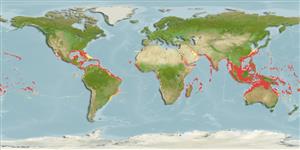Preferred temperature (Ref.
115969): 21 - 28.4, mean 27.1 (based on 1117 cells).
Phylogenetic diversity index (Ref.
82804): PD
50 = 0.5000 [Uniqueness, from 0.5 = low to 2.0 = high].
Bayesian length-weight: a=0.01738 (0.01424 - 0.02120), b=2.95 (2.92 - 2.98), in cm Total Length, based on LWR estimates for this species (Ref.
93245).
Niveau trophique (Ref.
69278): 4.5 ±0.8 se; based on diet studies.
Résilience (Ref.
120179): Faible, temps minimum de doublement de population : 4,5 à 14 années (K=0.12).
Prior r = 0.27, 95% CL = 0.16 - 0.47, Based on 1 stock assessment.
Fishing Vulnerability (Ref.
59153): High vulnerability (60 of 100).
